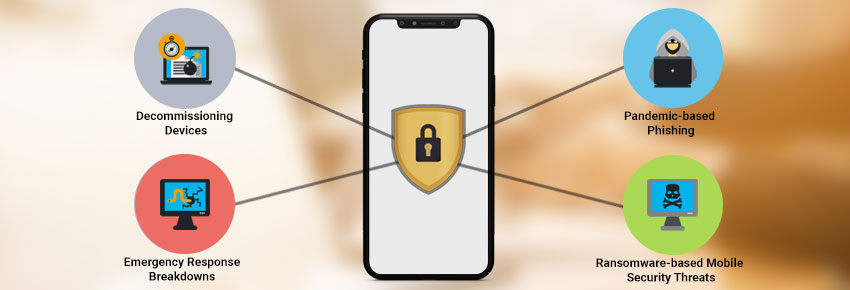Top Mobile Security Threats in 2021
Mai 07, 2021 | 42Gears Team

In 2021, mobile security threats are more severe than they’ve ever been before. This is due in large part to the COVID-19 pandemic, which has impacted almost every aspect of every industry
As businesses adopted remote work due to pandemic conditions, new weak points emerged. This is also true for companies that have returned to in-person work, as social distancing protocols add new obstacles to getting work done.
Of course, hackers lurk behind many threats. But some threats are entirely accidental, and can emerge anywhere in your organization. Learning to resolve these threats can make your organization more resistant to the ongoing epidemic.
Let’s look at a few major mobile security threats in 2021, and see how to protect your company against them.
Pandemic-based phishing
Phishing, or posing as someone legitimate to obtain sensitive information, is a constant threat. But it’s different in the context of a pandemic.
The classic phishing scheme relies on urgent-sounding emails from an authority figure. If someone’s boss commands them to open an email link, most people will open that link. They only discover too late that a malicious actor posed as the boss, and that the link has now infected the computer with malware.
This holds true during the pandemic, but phishing can also add emotional appeals around COVID-19. Links that appear to provide emergency epidemic updates are an easy way to lure users to malicious links. Plus, the rise of phishing via mobile texting means phishing can occur anywhere.
How to Protect Yourself: To ensure no one can pose as you to send malicious links, clearly indicate to your employees that you will send alerts in a specific way. For example, you might broadcast an alert via mobile device management. It’s not fair to put employees in the position of deciding whether an important-looking message is real.
Ransomware-based mobile security threats
Ransomware, or locking down a device until the owner pays a ransom, has been a major problem throughout the pandemic. Hackers have even targeted critical medical data needed to research COVID-19 cures.
This isn’t just a scourge on computers; mobile ransomware is now a major threat to watch out for as well. Smartphones have all sorts of personal information, and losing phone functionality is arguably more disruptive than losing access to a computer. After all, if someone can’t call for help in the event of an emergency, that emergency becomes much more dire.
How to Protect Yourself: As ransomware is an urgent threat, developers will target it in emergency patches. This means keeping devices updated is essential. If any employees use phones that aren’t completely safe, it’s a big liability. Another option is to restrict what apps users can access, You can create a standalone app store (known as an enterprise app store) using mobile device management software. From there, you can designate specific apps for users to download while blocking the rest, cutting down the chance of risky downloads.
Decommissioning Devices
Working from home brings a number of threats. For example, home Wi-Fi networks may not be as secure as office networks. Burglary is also a threat if workers take devices with them on the go.
However, a new issue in the pandemic is especially dire. If employees leave a company during the pandemic, but they have work-owned devices at home, this creates a tricky situation.
When employees leave your company, they’d normally return any devices you gave them. But when social distancing, workers may not be able to come to your offices to return the devices. This means ex-employees may still have devices for a company that no longer employs them.
It’s risky for ex-employees to owe you devices that you can’t get back right away. After all, if they’re not worried about being fired, they will be less concerned about keeping the data on your devices safe from mobile security threats.
How to Protect Yourself: You should have a way to remotely wipe work data off any work-owned device. That way, if the device has to stay with the ex-employee, the employee cannot compromise the device data in any way.
Emergency Response Breakdowns
Even though smartphones are liabilities, they are also essential to helping employees return to work. For example, solutions like the Domo’s health-tracking app let temperature scanners work in conjunction with employee devices to keep track of everyone.
If smartphones stop working for any reason, this puts employees in a difficult spot as they return to the workplace. For example, if someone is coming into work late, and their phone isn’t working, they will need to go home.
This could also become a major issue when relaying the news of a reported COVID-19 case at work. If any workers do not receive the memo because of a malfunctioning phone, they become liabilities to themselves and others.
How to Protect Yourself: This kind of issue could occur if devices do not have the latest firmware, OS updates, and so on. If you can remotely keep every device up-to-date, you’ll be in a much better position to prevent this from happening.
Next Steps for Protecting Against Mobile Security Threats
Phishing, ransomware, ex-employees, and device malfunctions are only a small number of the security liabilities companies face in 2021. However, the techniques you use to counter these threats will also be useful for others as well.
All of the protective measures mentioned above are possible through a mobile device management solution. By choosing an option like SureMDM by 42Gears, you can remotely update or wipe devices from one central console. You can even use SureMDM as an emergency broadcast system.
It’s never too late to tighten up your company’s defenses. Try SureMDM today.
Gain an edge against security threats
with SureMDM
Subscribe for our free newsletter
